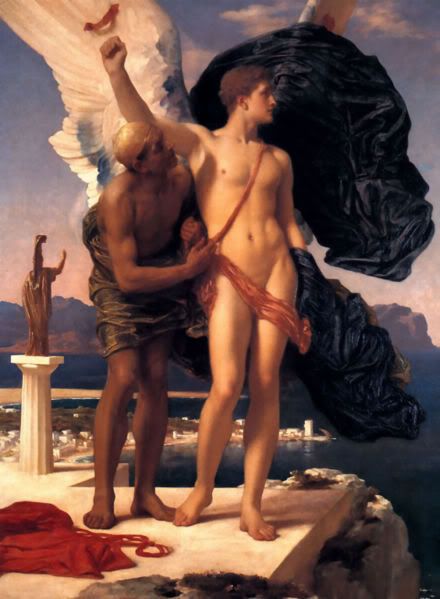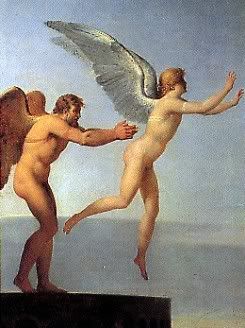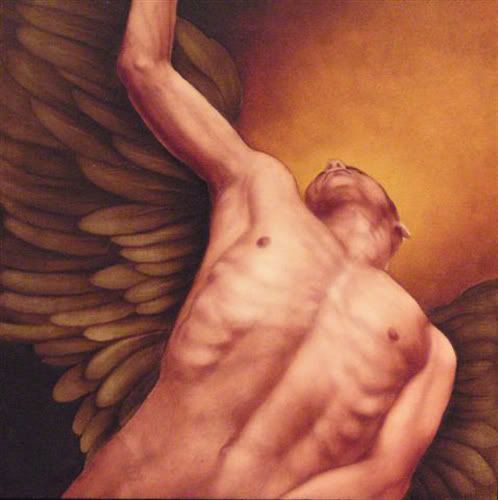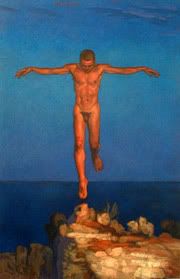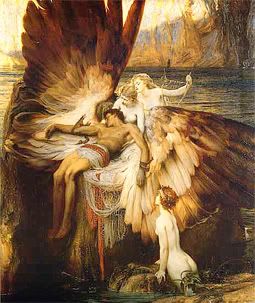Thêm thông tin về địa điểm tai nạn của
Icarus. Ngay cạnh chiếc thuyền ở gần bờ có thể thấy 1 cái chân của Icarus.
Có thể thấy rõ là Icarus chưa được
Daeralus huấn luyện đến nơi đến chốn kỹ thuật bay trong đó có kỹ thuật bay thermal và bay cross country, dẫn đến chỉ là 1 cú airborne định mệnh như trong tranh. Báo cáo về nguyên nhân của vụ tai nạn được giữ tuyệt mật cho đến tận ngày nay, tuy nhiên một số thông tin về kết quả điều tra đã bị rò rỉ trên wikileaks.org và wikipedia.org. (
http://en.wikipedia...._Fall_of_Icarus)
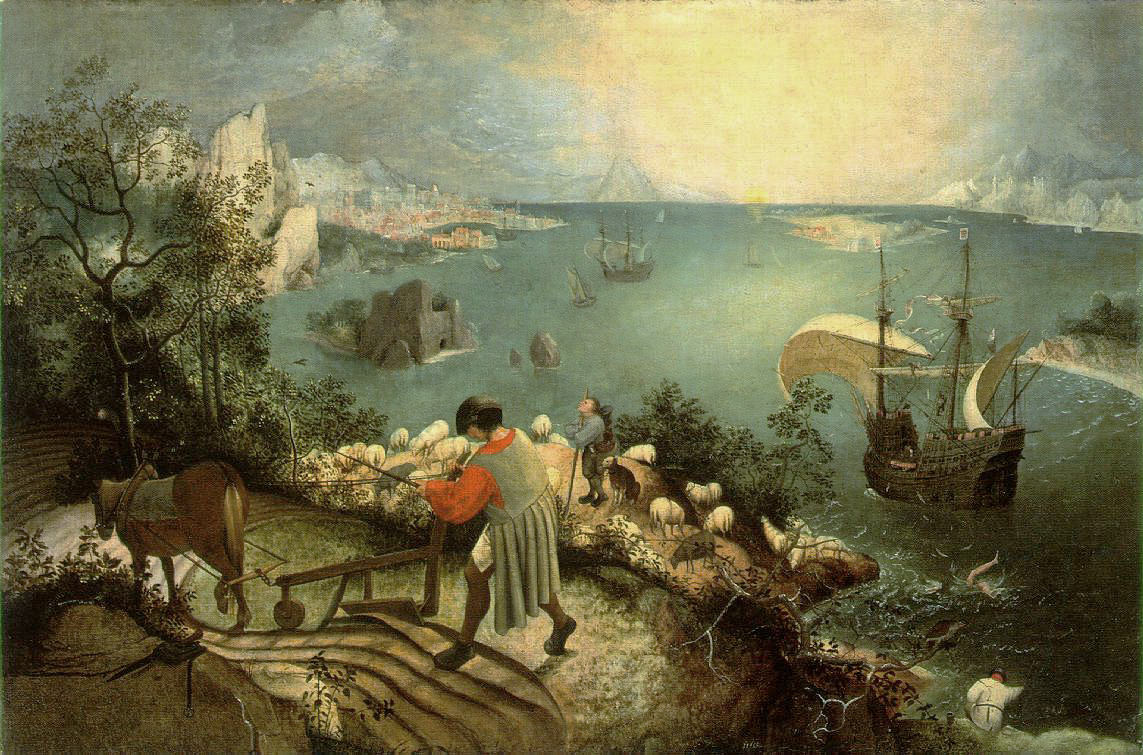
Ngoài ra anh em cũng có thể xem thêm thông tin về
Daedalus người thiết kế đôi cánh và huấn luyện
Icarus bay ở dưới đây.
Daedalus là nhân vật chính, là người thiết kế đôi cánh, đã bay thành công đến đích và tránh được các rủi ro của chuyến bay. Chắc chắn Daedalus là một anh hùng. Có những điều rất thú vị song hành trong bay lượn tự do: sử dụng dù lượn thi đấu để đua ‘hết tốc lực’ là chiến lược của Icarus còn Daedalus có lẽ sẽ chọn một cánh dù DHV 2 ‘thật ngon’. Dấn thân vào vùng thermals mặt sau núi để giành chiến thắng trong thi đấu là tinh thần của Icarus còn hạ cánh vì các điều kiện quá mạnh thì đó chính là Daedalus. Bay quá cao mà không cần oxy chắc chắn là cách mà ai đó trong chúng ta bắt chước Icarus, nhưng chỉ bay dưới 12.000 ft (4000m) thì có lẽ là cách mà Daedalus đã bay.
http://www.xcmag.com...forgotten-hero/
Daedalus, The Forgotten Hero
Every competitor wants to be the first to goal. We all know that, and congratulate the first pilot home after a task. Yet, deeply buried in the distant annals of history, the very first pilot to make goal has been forgotten about, the poor soul. Instead, it s the guy who crashed, burned and died who is the celebrated hero of free flight. I am, of course, referring to the Legend of Daedalus and Icarus.
According to ancient Greek mythology, Daedalus and his son Icarus were put in prison by King Minos of Crete because Daedalus helped kill the Minotaur and escape with the king s daughter, the beautiful Ariadne. Daedalus, well known as a genius, knew that he couldn t escape by sea or land, as Minos security was too tight. So he hatched the idea of escaping by flying. Daedalus got to work, and built wings of string, feathers, reeds and wax to allow him and his son to escape. In many ways his design wasn t dissimilar to the first rogallos made from bamboo and polythene in the 1960s.
Before they took off, Daedalus gave Icarus a pre-flight briefing: don t fly too low, or the feathers would get wet and stick, and don t climb too high or the sun will melt the wax and the wings will disintegrate.
The rest is history. Daedalus launched first, flew sensibly, crossed the sea and got to goal safely, being the first pilot to do so. Meanwhile, his young charge Icarus was so exhilarated by flight that he flew too high. The hot sun melted his wing fixings and he fell to his death in the waters below. Daedalus buried his son’s body on the island of Icaria, and the sea in which he drowned became known as the Icarian Sea.
Icarus entered into myth lore and became a legend. Meanwhile his Dad, Daedalus, who designed the wings, built them and flew them to goal, headed into obscurity.
Fast forward a few hundred years, and whilst Icarus often crops up in our conversations (what with Icaro 2000, the Couple Icare and Bruce Goldsmith s Icaristics columns), you don t exactly hear Daedalus mentioned often. There is no Daedalus cup and no glider or instrument has ever been named after Daedalus.
I find this hard to understand. People outside our sport subscribe to the Icarus image of free flying. Last year in France, lying in hospital with a broken leg and broken arm, lots of the nurses shook their heads and remarked: Coupe Icare, oh merde! In me, they saw yet another person trying to emulate his hero Icarus, but ending up bent and broken after the wings folded up.
For me, Daedalus is the main man. He designed a wing, successfully flew it to goal and avoided the hazards of flight. Surely a hero. There are interesting parallels throughout free flying: racing full-blown competition gliders is an Icarian strategy, whereas Daedalus would choose a nice DHV 2 machine. Roughing it in leeside thermals to win a comp is the mentality of Icarus, whereas landing because the conditions are too strong is so Daedalus. Flying too high without oxygen is definitely the closest any of us will get to imitating Icarus, but staying below 12,000 ft is the way Daedalus would have flown.
Despite all this, Daedalus has been forgotten by free flying. But having recently suffered the consequences of a serious accident, I’ll definitely be looking to emulate Daedalus from now on.
(
http://en.wikipedia.org/wiki/Daedalus)
In
Greek mythology,
Daedalus (Latin, also Hellenized Latin
Daedalos, Greek
Daidalos (
Δαίδαλος) meaning "cunning worker", and Etruscan
Taitale) was a skillful craftsman and artisan.
[1] Daedalus had two sons:
Icarus and
Iapyx, along with a nephew, whose name is
Perdix. He is first mentioned by
Homer as the creator of a wide dancing-ground for
Ariadne.
[2] The
Labyrinth on
Crete, in which the
Minotaur (part man, part bull) was kept, was also created by the artificer Daedalus. In the story of the labyrinth Hellenes told, the Athenian hero
Theseus is challenged to kill the Minotaur, finding his way with the help of
Ariadne's thread. Daedalus' appearance in Homer is in an extended simile, "plainly not Homer's invention,"
Robin Lane Fox observes: "he is a point of comparison and so he belongs in stories which Homer's audience already recognized."
[3] In Bronze Age Crete, an inscription
da-da-re-jo-de has been read as referring to a place at Knossos,
[4] and a place of worship.
[5]
In Homer's language, objects which are
daidala are finely crafted. They are mostly objects of
armour, but fine bowls and furnishings are
daidala, and on one occasion so are the "bronze-working" of "clasps, twisted brooches, earrings and necklaces" made by
Hephaestus while cared for in secret by the goddesses of the sea.
[6]
Ignoring Homer, later writers envisaged the
labyrinth as an edifice rather than a single dancing path to the center and out again, and gave it numberless winding passages and turns that opened into one another, seeming to have neither beginning nor end.
[7] Ovid, in his
Metamorphoses, suggests that Daedalus constructed the
Labyrinth so cunningly that he himself could barely escape it after he built it.
[8] Daedalus built the labyrinth for King
Minos, who needed it to imprison his wife's son the
Minotaur. The story is told that
Poseidon had given a white bull to
Minos so that he might use it as a sacrifice. Instead, Minos kept it for himself; and in revenge, Poseidon made his wife
Pasiphaë lust for the bull.
[9] For Pasiphaë, as Greek mythologers interpreted it, Daedalus also built a wooden cow so she could mate with the bull, for the Greeks imagined the Minoan
bull of the sun to be an actual, earthly bull.
Athenians transferred Cretan Daedalus to make him Athenian-born, the grandson
[10] of the ancient king
Erechtheus, who fled to Crete, having killed his nephew. Over time, other stories were told of Daedalus. In the nineteenth century,
Thomas Bulfinch combined these into a single synoptic view of material which Andrew Stewart calls a "historically-intractable farrago of 'evidence', heavily tinged with Athenian cultural chauvinism".
Contents
Daedalus and his nephew
Daedalus was so proud of his achievements that he could not bear the idea of a rival. His sister had placed her son, named variously as
Perdix, Talos, or Calos, under his charge to be taught the mechanical arts. He was an apt scholar and showed striking evidence of ingenuity. Walking on the seashore, he picked up the spine of a fish. According to Ovid, imitating it, he took a piece of iron and notched it on the edge, and thus invented the saw. He put two pieces of iron together, connecting them at one end with a rivet, and sharpening the other ends, and made a pair of compasses.
[11] Daedalus was so envious of his nephew's accomplishments that he took an opportunity, when they were together one day on the
Acropolis of Athens,
[12] to push him off. But
Athena, who favors ingenuity, saw him falling and arrested his fate by changing him into a bird called after his name,
perdix, the
partridge. This bird does not build his nest in the trees, nor take lofty flights, but nestles in the hedges, and mindful of his fall, avoids high places. For this crime, Daedalus was tried and banished.
Daedalus and Icarus
It is in images, not in texts that Daedalus is seen with wings;
[13] many Greek myths appear to have been invented to make sense of known but inexplicable images. The most familiar literary telling explaining Daedalus' wings is a late one, that of Ovid: in his
Metamorphoses (VIII:183-235) Daedalus was shut up in a tower to prevent his knowledge of his Labyrinth from spreading to the public. He could not leave Crete by sea, as the king kept strict watch on all vessels, permitting none to sail without being carefully searched. Since Minos controlled the land and sea routes, Daedalus set to work to fabricate wings for himself and his young son
Icarus. He tied feathers together, from smallest to largest so as to form an increasing surface. The larger ones he secured with thread and the smaller with wax, and gave the whole a gentle curvature like the wings of a bird. When the work was done, the artist, waving his wings, found himself buoyed upward and hung suspended, poising himself on the beaten air. He next equipped his son in the same manner, and taught him how to fly. When both were prepared for flight, Daedalus warned Icarus not to fly too high, because the heat of the sun would melt the wax, nor too low, because the sea foam would soak the feathers.
They had passed
Samos,
Delos and
Lebynthos by the time the boy, forgetting himself, began to soar upward toward the sun. The blazing sun softened the wax which held the feathers together and they came off. Icarus fell into the sea and drowned. His father cried, bitterly lamenting his own arts, and called the land near the place where Icarus fell into the ocean
Icaria in memory of his child.
An early image of winged Daedalus appears on an
Etruscan jug of ca 630 BC found at
Cerveteri, where a winged figure captioned
Taitale appears on one side of the vessel, paired on the other side, uniquely, with
Metaia,
Medea:
[14] "its linking of these two mythical figures is unparalleled," Robin Lane Fox observes: "The link was probably based on their wondrous, miraculous art. Magically, Daedalus could fly, and magically Medea was able to rejuvenate the old (the scene on the jug seems to show her doing just this)".
[15] The image of Daedalus demonstrates that he was already well known in the West.
Sicily
Further to the west, Daedalus arrived safely in
Sicily, in the care of King
Cocalus of Kamikos on the island's south coast; there he built a temple to
Apollo, and hung up his wings, an offering to the god. In an invention of
Virgil (
Aeneid VI), Daedalus flies to
Cumae and founds his temple there, rather than in Sicily; long afterwards Aeneas confronts the sculpted golden doors of the temple.
Minos, meanwhile, searched for Daedalus by travelling from city to city asking a riddle. He presented a spiral seashell and asked for a string to be run through it. When he reached Kamikos, King Cocalus, knowing Daedalus would be able to solve the riddle, privately fetched the old man to him. He tied the string to an ant which, lured by a drop of honey at one end, walked through the seashell stringing it all the way through. Minos then knew Daedalus was in the court of King Cocalus and demanded he be handed over. Cocalus managed to convince Minos to take a bath first, where Cocalus' daughters killed Minos. In some versions, Daedalus himself poured boiling water on Minos and killed him.
The anecdotes are literary, and late; however, in the founding tales of the Greek colony of
Gela, founded in the 680s on the southwest coast of Sicily, a tradition was preserved that the Greeks had seized
cult images wrought by Daedalus from their local predecessors, the
Sicani.
[16]
Innovator
Such anecdotal details as these were embroideries upon the reputation of Daedalus as an innovator in many arts. In
Pliny's Natural History (7.198) he is credited with inventing carpentry "and with it the saw, axe, plumb-line, drill, glue, and
isinglass".
Pausanias, in travelling around Greece, attributed to Daedalus numerous archaic wooden
cult figures (see
xoana) that impressed him: "All the works of this artist, though somewhat uncouth to look at, nevertheless have a touch of the divine in them."
[17]
Daedalus gave his name,
eponymously, to any Greek artificer and to many Greek contraptions that represented dextrous skill. At
Plataea there was a festival, the
Daedala, in which a temporary wooden altar was fashioned, and an effigy was made from an oak-tree and dressed in bridal attire. It was carried in a cart with a woman who acted as bridesmaid. The image was called
Daedale and the archaic ritual given an explanation through a myth to the purpose.
In the period of
Romanticism, Daedalus came to denote the classic artist, a skilled mature craftsman, while
Icarus symbolized the romantic artist, an undisputed prototype of the classic artist, whose impetuous, passionate and rebellious nature, as well as his defiance of formal aesthetic and social conventions, may ultimately prove to be self-destructive.
Stephen Dedalus, in Joyce's
Portrait of the Artist as a Young Man envisages his future artist-self "a winged form flying above the waves [...] a hawk-like man flying sunward above the sea, a prophecy of the end he had been born to serve”
